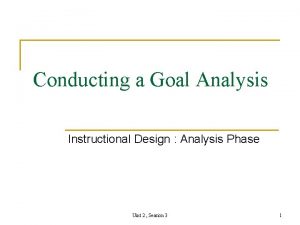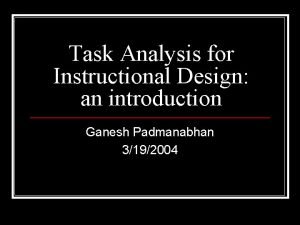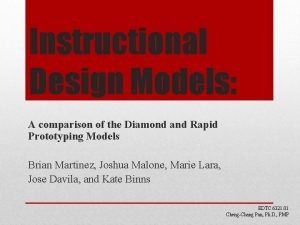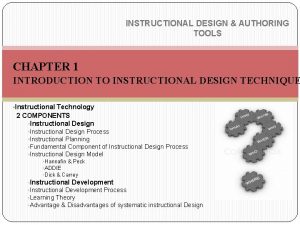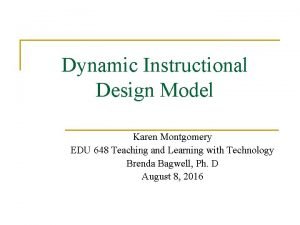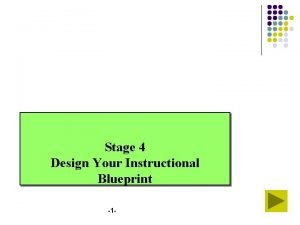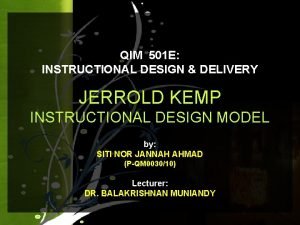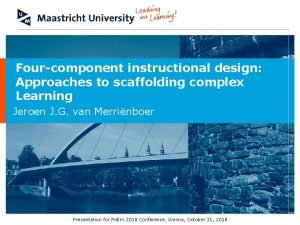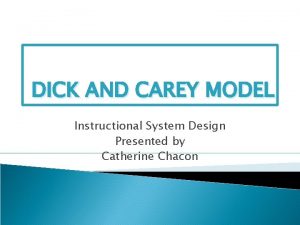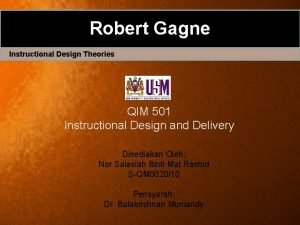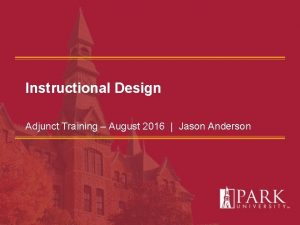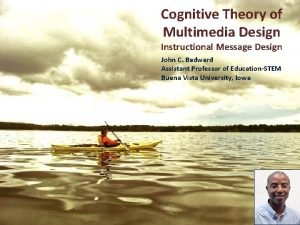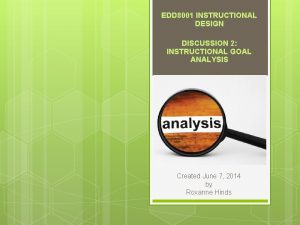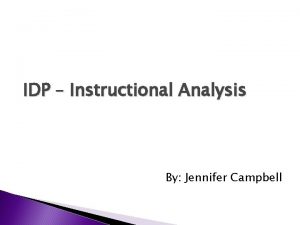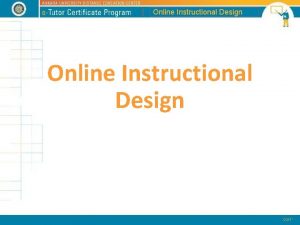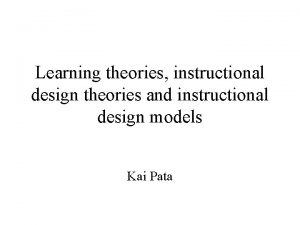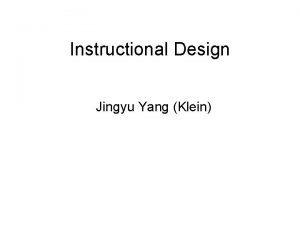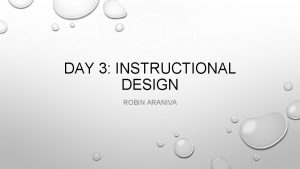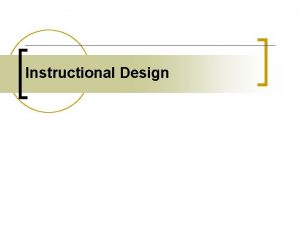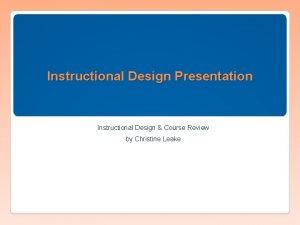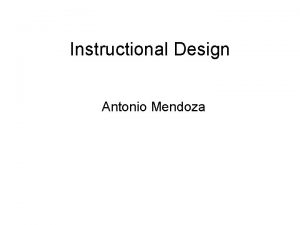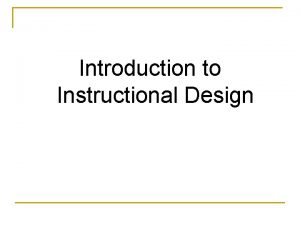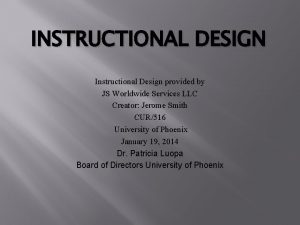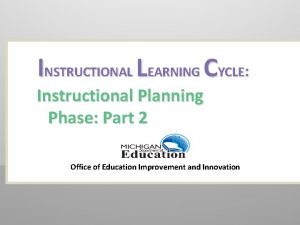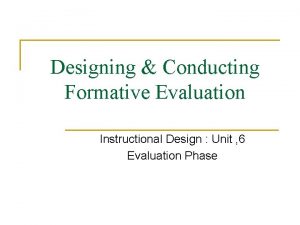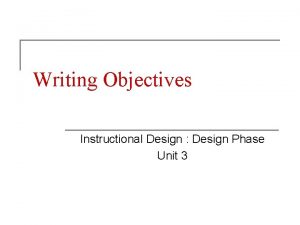Conducting a Goal Analysis Instructional Design Analysis Phase


















- Slides: 18

Conducting a Goal Analysis Instructional Design : Analysis Phase Uint 2 , Session 3 1

Session objective: by the end of this session you should be able to: q q Classify instructional goals into : intellectual skills, verbal information, psychomotor skill , and attitudes. Perform a goal analysis to identify the major steps required to accomplish an instructional goal Uint 2 , Session 3 2

Conducting a Goal Analysis A way to identify Instructional /training content n Id all skills & knowledge to be include in the instruction Too Little? Too Much? Uint 2 , Session 3 3

Instructional Analysis n n Is a set of procedures applied to an instructional goal results in the identification of the relevant steps for performing the goal. Is a visual representation of what the learner should be doing to learn the goal. Uint 2 , Session 3 4

Goal Analysis - Two Steps � 1. Classify according to the type of learning outcome (domain of learning) q � psychomotor, intellectual, verbal information, attitudes 2. Describe exactly what a students will be doing when performing the goal q using observable verbs like moving, painting, etc. Uint 2 , Session 3 5

Verbal Info. Vs Intellectual Skills n Verbal Information (facts) q q n declarative knowledge, “knowing that” is added to information already in memory Intellectual Skills q “knowing how” as opposed to know that Uint 2 , Session 3 6

Psychomotor Skills n n n The learner must use muscular action With or without equipment To reach specified results Uint 2 , Session 3 7

Affective Skills - Attitudes n n Learners will “choose” to do something¨ A tendency to make particular choices Probably will not be achieved at the end of the instruction Evaluation by “doing something” Uint 2 , Session 3 8

Goal Analysis continued n Decide if substeps (subgoals) are necessary q q n complexity of the task target audience Finally, formulate a test item that would show that learners can perform the skill? Uint 2 , Session 3 9

Goal analysis n Once your design team has conducted analyzed your needs assessment you will need to conduct what is referred to as a Goal Analysis. A Goal analysis is simply an analysis of your instructional goal considering such elements as learning domains, and the identification of all the skills and knowledge needed in the instruction to accomplish the goal. Uint 2 , Session 3 10

Cont. n Since goals are usually written as broad encompassing statements, the instructional design team needs to look carefully at the goal and identify what measurable or observable behaviors would demonstrate the meeting of the instructional goal. To accomplish this task the design team will need to consider various learning domains: psychomotor, intellectual (or cognitive), verbal, and attitudinal. Not all goals will contain all of the domains, but the designer needs to consider them in the context of the goal itself. Uint 2 , Session 3 11

n The key to analyzing any goal, step, or task, is to recognize that the task must be presented in outcome behavioral terms. There needs to be some type of behavior to demonstrate that the goal has been met Uint 2 , Session 3 12

Task analysis n The analysis (task analysis) of the instructional goal presents a series of steps needed to be taken in order for the goal to be realized. Once the basic analysis is completed, and various decisions points are recognized and accounted for, an analysis of the "steps" or tasks is then required (sub-task analysis or subordinate skills analysis ). It is similar to completing a goal analysis except the designer is now analyzing each individual step or task. What are the sub-steps needed to complete this one step Uint 2 , Session 3 13

Procedural analysis Uint 2 , Session 3 14

Subordinate skills analysis Uint 2 , Session 3 15

Hierarchical approach n n Hierarchical approach is used to analyze goals that are identified as being intellectual or psyomotor skills Foundational knowledge or rules need to be taught/learned before the steps are taught Subordinate skills are analyzed for the skills and know ledges needed to meet them, then those skills are further analyzed. What must a learner know or be able to do in order to accomplish the subordinate skill The hierarchical approach is a top down model, each lower step supports the skills required by the steps above it. Uint 2 , Session 3 16

Cluster analysis n n n Cluster analysis is used with the verbal domain (information) Goals where no logical order is required to meet the goal Designer needs to identify the clusters or categories of information in each goal Uint 2 , Session 3 17

Instructional Analysis for Attitude Goals n A combination of both hierarchical and cluster analysis Uint 2 , Session 3 18
 Goal analysis instructional design
Goal analysis instructional design Task analysis instructional design
Task analysis instructional design Comparing instructional design models
Comparing instructional design models Instructional design authoring tools
Instructional design authoring tools Dynamic instructional design model
Dynamic instructional design model Assure model pros and cons
Assure model pros and cons Concept of teaching
Concept of teaching Addie modeli
Addie modeli Kemp model example
Kemp model example Ask fhml
Ask fhml Dick and carey instructional design model
Dick and carey instructional design model Assure instructional design model
Assure instructional design model Conclusion of gagne theory
Conclusion of gagne theory Katie conley model
Katie conley model Sam instructional design
Sam instructional design Flexspace csu
Flexspace csu Kemp's instructional design model
Kemp's instructional design model Instructional message design
Instructional message design Normal phase vs reverse phase chromatography
Normal phase vs reverse phase chromatography
